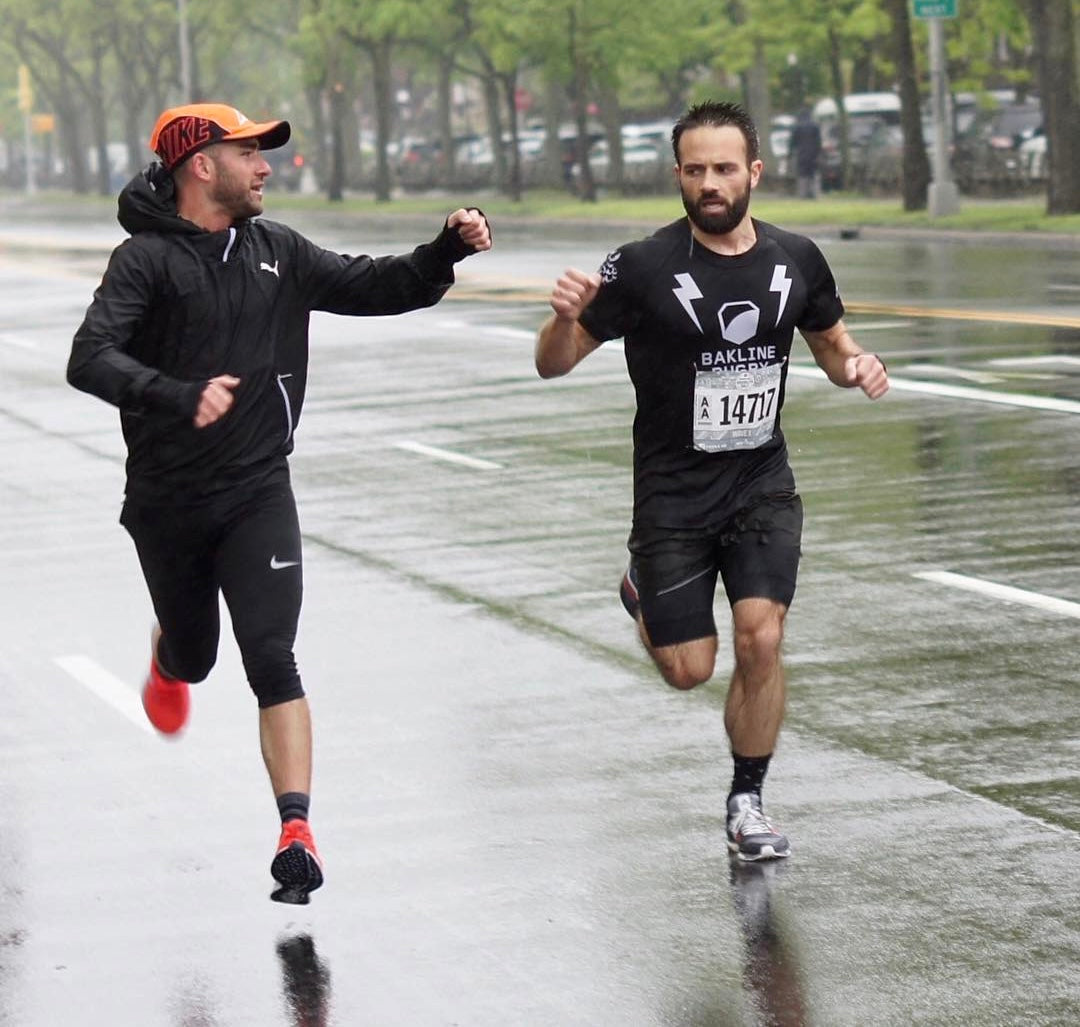In our first post of this series, we talked about muscle fiber types and how each contributes to an athlete’s speed and endurance. We made the case that rather than thinking of these as distinct or competing attributes fueled by different energy systems, fast and slow twitch fibers can–when properly trained–work in a highly efficient harmony. We see aerobic capacity and lactate metabolism as the primary components to building speed endurance, and in our own running and coaching we structure our training around complementary development of both attributes. In this post, we’ll be looking at what V̇O2 max and lactate threshold specifically measure, how they relate to what is playing out at the muscle fiber level, and what these numbers do (and don't) tell us about fitness.
As we laid out in our previous post, the traditional model of endurance capacity tends to cast muscle fibers as warring factions of angelic slow twitch (ST) fibers that toil tirelessly as they virtuously burn fat and consume the purest oxygen, while their fast twitch (FT) fiber brethren guzzle glycogen stores and spew lactic acid waste products with abandon, like some kind of metabolic dumpster fire. Endurance athletes are commonly encouraged to focus their training on developing ST fiber through long slow distance runs and to be cautious with ‘anaerobic’ workouts that recruit too many FT fibers and flood their bloodstream with the dreaded burn of lactate.

In this worldview, the best way to improve aerobic capacity is to focus primarily on building greater capacity in the hard-working ST oxidative fiber for energy production from our forever-fuel, fat. Since this is a lengthy chemical reaction with dozens of steps, it proceeds slowly and that rate can only be minimally improved through training. So if we need to increase our ATP output to enable us to run faster and we can't meaningfully speed up the rate we make ATP, our only option is to train in a way that stimulates our muscle fiber to build more ATP factories.
So we now arrive at the philosophy that drives long, slow distance (LSD) training: Run slowly enough to rely almost exclusively on ST fibers and stress those fibers through very long efforts. And remember--that's the only stress option available, since adding speed or intensity will necessitate recruitment of FT fibers. If you stress them long enough they will respond by growing new mitochondria and making other improvements to the oxidative system that increase overall aerobic capacity. But as we will demonstrate in this post, aerobic capacity is only one factor contributing to endurance performance, and how it is best optimized is more complicated than the LSD model suggests.
UNDERSTANDING V̇O2 MAX
The measure of aerobic capacity, VO2 max, is probably the most common metric endurance athletes will encounter. Many GPS watches even provide a V̇O2 max estimate after each workout. Yet what this number represents and how it actually relates to overall fitness and running performance is sometimes less clear. To demonstrate what V̇O2 max means in physical terms, let’s imagine an athlete doing a workout:
We join our hypothetical runner just as she finishes her warm-up and is about to start a set of hard mile repeats. She's been running easy and her breathing and heart rate are steady. Inside her lungs, blood circulates with each stroke of her heart, picking up oxygen and carrying it to working muscles. As the oxygenated blood enters narrow capillaries at the muscle bed, the oxygen bonds loosen, allowing it to diffuse into muscle fiber and eventually into the mitochondria for use in oxidative energy production.

During her warm-up, our runner has only been using a fraction—maybe 50-60%—of her total aerobic capacity. Running at an easy pace, her muscles’ ATP requirements are well below her capacity to produce it, and none of the pathways described above are taxed by the effort to deliver the needed oxygen. As she picks up the pace and starts her workout, however, her energetic demands will increase and she will need to supply more oxygen to her muscles to meet their ATP requirements.
How much of the needed energy she can supply through oxidative pathways is directly dependent on her total aerobic capacity, which is result of a combination of factors:[1]
- How much air she can pull into her lungs
- How much blood her heart can move with each contraction
- How much hemoglobin she has in her blood to facilitate transporting that oxygen
- How dense her capillaries are at her muscle fiber
- How many mitochondria she has in her muscle fiber that can consume oxygen to produce ATP
As our runner increases her intensity, each of these pathways is taxed and she will eventually reach a point at which one or more of these mechanisms is at its maximum. At this point, even if more oxygen were provided, she would not be able to use it, either due to limitations in extraction, delivery, or processing capabilities. The point at which her system is maxed out–the absolute maximum volume of oxygen she is able to functionally utilize–is defined as her aerobic capacity. If we want to quantify this in a way that allows us to use it as a comparative measure, we can record the total volume of O2 in liters she can use in the course of a minute and divide that by her weight in kilograms (which would help to compensate for people of varying sizes). And there you go–we have measured our runner’s V̇O2 max! The bigger the number, the more oxygen she's able to use and hence and the larger her aerobic capacity.
WHY WE CARE ABOUT THIS NUMBER
But let’s pause here. You might now be wondering why this somewhat esoteric measurement of a rate of oxygen consumption is so often presented as the holy grail of distance running. You might even be wondering why using a large volume of oxygen is even a good thing.*
The reason is that during aerobic exercise, 90-95% of oxygen consumption is utilized in energy production, so measuring V̇O2 max gives us a pretty good proxy for the maximum amount of energy an athlete can produce through aerobic processes. To return to the philosophy behind traditional endurance training, the bigger that number, the more energy a runner can aerobically produce and turn into running power. Since measuring breathed gas exchange is much easier than counting ATP molecules whilst someone is running, estimating consumed O2 has become a standard proxy (and cultural shorthand) for estimating the rate of aerobic energy production.

As the saying goes, though, we give medals for winning races, not for having the highest V̇O2 max on the starting line. Among professional runners, V̇O2 max turns out to be a pretty poor predictor of performance [2] though,** and this very point is, in fact, where things start to get interesting. Recall from our previous post that we also have energy production pathways that do not require oxygen, meaning that V̇O2 max–aerobic capacity–is only a partial reflection of an athlete’s full ability to produce power. To see why that distinction is important, let’s return to our runner, now in the middle of her second mile repeat:
Approaching a hill, she will require additional power to maintain her speed through the rep, and with her oxidative fibers already working near full capacity, she needs to recruit additional fast twitch muscle to power up the hill. FT fibers have few mitochondria and the majority of the ATP they require is produced from glycogen stores in a chemical reaction that does not require oxygen. As we described in our previous post, this reaction occurs very quickly within the working fiber,[3] but only a small portion of the energy stored in the glycogen is released through the anaerobic reaction. While this process is less fuel efficient from an energy-per-molecule standpoint than aerobic production of ATP, it is far more efficient from a time perspective. Here the ATP can immediately be consumed within the working muscle fiber as soon as it’s created, supplying energy 100 times faster than the oxidative pathway. As a result of the quick (but partial) reaction, leftover portions of the glycogen molecule (called pyruvate) remain in the fiber along with positively charged hydrogen ions. What happens to these components next will depend on a number of factors, as we will see.

Let’s return to our runner, and for a bit of context, let’s imagine that she’s just come off a road-mile training cycle with lots of track work and is now transitioning to marathon training. After spending the last few months focusing on sprints to develop her speed and turnover, she has plenty of fast twitch fiber at the ready to maintain her pace up the hill. She powers up the incline, but by the time she reaches the top, her legs feel heavy and wobbly. Her FT fiber has done its job a little too well–swift anaerobic energy production has created hydrogen ions faster than her muscles can manage them, and within her FT cells the environment has become so acidic that the fibers can no longer contract effectively. With her anaerobic pathways maxed out, our runner must now rely entirely on her aerobic system both to supply the energy for movement and for processing the metabolic byproducts of her hill sprint. With much of her FT fiber working at limited capacity and with her oxidative fiber doing double-duty, our runner is forced to slow down. Even running at a slower pace, her breathing and heart rate will continue to increase until her oxygen demands are met. We’ve all been there.
In a second scenario, let’s imagine our athlete has just come off an old-school base-building phase and she’s spent the past several months only running easy pace. In this case when she begins her hill climb, she might find that she feels a little underpowered. While her slow twitch fiber is optimized after all the aerobic training, her FT fiber has gotten far less airtime. Her ability to recruit her fastest and most powerful fibers will be limited, and while she’ll have little of the anaerobic byproducts building up from our previous example, she’ll still have to slow her pace up the hill to match the slower energy metabolism and lower force production of her aerobic system. In this example, her pace and power are capped by the limitations of her slow twitch fiber.
As a final thought experiment, let’s now put our runner in the final block of a well-constructed marathon training cycle. As she starts up the hill, she successfully recruits FT fiber and taps into her glycogen reserves for anaerobic ATP production. She’s able to produce adequate power to maintain her pace up the hill, and once again the byproducts of glycolysis are formed in her working muscle. In this case, however, her prior training adaptations have ensured that a large number of transporter molecules are at the ready in her muscle fibers. As glycogen is broken down in her FT cells, the resulting pyruvate molecules and free-floating hydrogen ions combine to form more stable lactate molecules. The h+ ion that would otherwise lower her cellular pH is bound, and lactate is moved out of the fiber and into the bloodstream by a transporter molecule.[5] Once in circulation, the lactate is an available fuel source for other tissues. When it reaches a muscle fiber with oxidative capacity, it is picked up by a different transporter molecule which escorts it into the mitochondria. Now in an aerobic environment, the lactate is split back into pyruvate–which can undergo oxidative metabolism to produce 30 more ATP, and hydrogen–which is bonded with available oxygen to form water.
BRINGING IT TOGETHER: SYSTEMS IN BALANCE
How beautiful is that? In this scenario, our runner gets to fully utilize the power of her FT fiber while her ST fibers unlock the remaining energy left in their ‘waste products.’ The aerobic metabolism of pyruvate requires less oxygen than metabolizing fat, so she actually lowers her oxygen cost [4] when both systems operate symbiotically. And as an added benefit, this process slows accumulation of fatigue-creating acid and extends her FT muscular endurance. The maximum pace she can sustain in this state is known as critical speed (CS), the speed she can maintain that until increased intensity or other aspects of fatigue elevate her circulating lactate levels to about four times their normal resting value. This point is commonly referred to as lactate threshold (LT). The percentage of her V̇O2 max just before this happens is what determines the portion of her aerobic capacity that she can functionally utilize, which is the true measure of performance in longer distance events.
With these three examples we hope to have illustrated how an athlete with the same V̇O2 max could perform very differently based on training status. In our first example of a speed-oriented athlete, her easily-recruited FT fiber comes online too early as the intensity increases. She can produce a lot of power in the short term, but lacks the necessary machinery to buffer and redistribute the resulting metabolic products. The portion of her V̇O2 max available to her before her system essentially is flooded is lower, meaning that she constantly needs to hold back her pace to avoid tipping into an unsustainable metabolic state.
In the second example, our runner might be able to effectively access a large portion of her V̇O2 max because she doesn’t really have to worry about dipping too far into her largely inaccessible anaerobic reserves. The down side of that is that without the ability to recruit fast fiber she will feel underpowered and lack speed. She may feel like she can go forever, but she won’t go very fast.
In our final scenario, our athlete has trained her energy systems to work together. She can sustain working at a high percentage of her V̇O2 max for a long time and still output considerable power and speed as she does so. Her aerobic system enables her FT fibers to work at a high efficiency while turning fatigue-producing metabolites into water and fuel, extending the time and distance she can sustain a faster pace. Well-balanced aerobic and anaerobic systems are the key to building that elusive quality of speed endurance, and they also translate into extra short-term speed to maintain pace on hills, surge past a competitor, or kick to the finish line. This balance and flexibility–not the V̇O2 max number on your watch–is the real holy grail of distance running.
WHAT WE CAN LEARN FROM VO2 MAX AND LACTATE THRESHOLD
On its own, a high aerobic capacity doesn’t translate directly to speed. Its real magic happens when it provides the machinery that allows FT fiber to join the endurance party. The better the systems work together, the higher her critical speed and faster our runner can go before she hits LT. In well-trained runners, V̇O2 max can be thought of as representing an athlete’s full aerobic potential. Where the lactate threshold occurs as a percentage of VO2 max represents the usable portion of that potential.
A runner may be gifted by genetics with a high VO2 max, but if they hit their lactate threshold when they are only consuming 70% of their maximal oxygen capacity, that last 30% is of limited use because it can only be accessed once the body is already under system-wide metabolic stress. In very well-trained endurance athletes, lactate threshold can occur as high as 80-85% of V̇O2 max, meaning that someone with a lower V̇O2 max number who can functionally use more of their capacity may be able to sustain a faster pace than their more genetically-gifted counterpart. Nature matters, but so does nurture.
In this way, previous training can have a major affect on your current physiology and development. If you were coming off a 10K cycle before to your last half marathon and this time you’re dropping down from a marathon, what worked in the last cycle may not be the stimuli you need this time. So before you look at a number on your watch to tell you where you are, ask yourself where you've been and where you're going. And of course, we're here to help you find your way! In our next post in this series we’ll dig into some specific workouts to improve speed endurance and how to implement them within a training plan.

*This is actually a very astute question, and one we’ll get to in a few weeks when we discuss running economy. Stay tuned.
**Yes, one can argue that professional runners all have very high aerobic capacities, and once you select a population for a specific attribute, it then becomes a less useful differentiator. That said, the fact that runners of similar V̇O2 max can perform very differently over the same course, or over different distances emphasizes the point that runners are not just lungs with legs.
REFERENCES
1. Apor P, Borka P. Az aerob funkciós rendszer korlátai [Limiting factors of aerobic capacity]. Orv Hetil. 2001 Dec 2;142(48):2673-9. Hungarian. PMID: 11778365.
2. Daniels J, Daniels N. Running economy of elite male and elite female runners. Med Sci Sports Exerc. 1992 Apr;24(4):483-9. PMID: 1560747.
3. Jeukendrup AE, Wallis GA. Measurement of substrate oxidation during exercise by means of gas exchange measurements. Int J Sports Med. 2005 Feb;26 Suppl 1:S28-37. doi: 10.1055/s-2004-830512. PMID: 15702454.
4. Krogh A, Lindhard J. The Relative Value of Fat and Carbohydrate as Sources of Muscular Energy: With Appendices on the Correlation between Standard Metabolism and the Respiratory Quotient during Rest and Work. Biochem J. 1920 Jul;14(3-4):290-363. doi: 10.1042/bj0140290. PMID: 16742941; PMCID: PMC1263890.
5. Brooks GA. The Science and Translation of Lactate Shuttle Theory. Cell Metab. 2018 Apr 3;27(4):757-785. doi: 10.1016/j.cmet.2018.03.008. PMID: 29617642.


